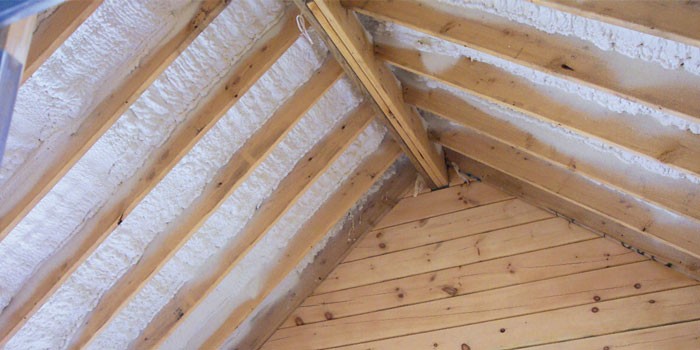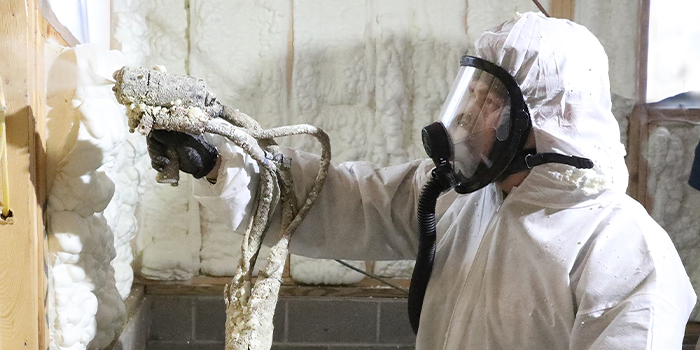Testing Code Requirements


The vast majority of unvented attics in residential construction are created by spray foam insulation below the roof deck and typically such applications allow for ignition barrier requirements to govern, rather than thermal barrier requirements. There are two legitimate testing approaches in the industry that allow the spray foam insulation to go bare if the applicable building code requirements are met. The pertinent sections in the IRC are:
R316.5.3 Attics “The Thermal barrier specified in section R316.4 is not required where all of the following apply:
- Attic access is required by Section R807.1
- The space is entered only for purposes of repairs or maintenance
- The foam plastic insulation has been tested in accordance with Section R316.6 or the foam plastic insulation is protected against ignition using a (prescriptive) ignition barrier material
- The ignition barrier is not required where the foam plastic insulation has been tested in accordance with Section R316.6”
R316.6 Specific Approval “Foam plastic….shall be specifically approved on the basis of one of the following approved tests: NFPA 286 with acceptance criteria of Section R302.9.4, FM 4880, UL1715, or fire tests related to actual end-use configurations.”
In general, foam plastic insulation does not need a thermal barrier in an attic if the requirements of section R316.5.3 are met and the attic is not used for storage. In such cases ignition barrier requirements are allowed. Further, the use of a prescriptive ignition barrier or an approved ignition barrier coating, like an intumescent paint, can be avoided if special approval testing requirements noted in R316.6 have been met.
To meet the R316.6 testing requirements for the omission of prescriptive ignition barriers, two test methods have been utilized by the spray foam industry: End use configuration testing as allowed by R316.6; or a modified version of NFPA 286 commonly referred to as “Appendix X.” The Appendix X test method is not recognized by the IRC like end use configuration testing is but it is recognized by ICC Evaluation Service in Acceptance Criteria (AC) 377.
The Appendix X method has a single purpose, to test flame spread on the surface of the foam caused by a burner in the floor corner of a prismatic room that is open to free flow of air. The thought behind this test is that if the flame does not spread by four minutes and 18 seconds then equivalent ignition barrier performance has been achieved. No consideration is given to what happens after the allotted time and whether or not the fire spreads then. Nor is consideration given to ensuring the assembly represents what an attic looks like.
End use configuration testing was designed, as its name states, with greater consideration going into the test assembly resembling real world factors and considerations. The intention of this test method is to account for what will actually happen when a fire is started in an attic and insure a result that maintains the health and safety of occupants. Attic shape including pitched roofs, foam thickness, attic hatches, penetrations through the floor, walls, and roof, are all a part of the test assembly configuration.
On top of those assembly considerations, “what if” considerations must be tested as well. What if the attic hatch is open? What if a bathroom vent fan is made of plastic? What if there is a hole in the roof? To answer these “what if” questions all manufacturers performing end use configuration tests end up performing multiple tests to address different possible scenarios. The end result is an excellent understanding of what goes on during an attic fire and plenty of fire tests to back it up.
End use configuration testing has shown that a properly installed unvented attic typically self-extinguishes in around one minute or less. The advantage of a self-extinguishing attic is obvious, but it can only be achieved when there is an understanding of what is required. This understanding comes from knowing what actually happens during an attic fire and having the answers to the “what ifs” based on many tested scenarios. Once correctly installed, spray foam insulation dealers and building occupants can rest assured that an optimal attic condition is in place, that the necessary approvals exist, and that building code requirements have been followed. •
Contact Icynene-Lapolla Direct any questions about testing code requirements and thermal barriers for attic applications to Icynene-Lapolla (Phone: 877-636-2648 / Website: www.icynene-lapolla.com)
*Spray Foam Magazine does not take editorial positions on particular issues; individual contributions to the magazine express the opinions of discrete authors unless explicitly labeled or otherwise stated. The inclusion of a particular piece in the magazine does not mean that individual staff members or editors concur with the editorial positions represented therein.
Disqus website name not provided.









































